In the manufacturing process of integrated circuits, there is an important part - lithography, because with it, we can achieve functions on tiny chips. Modern scribing techniques can be traced back to 190 years. In 1822, the Frenchman Nicephore niepce began to try to replicate an imprint (pattern) etched on oil paper after various materials lighting experiments. He placed the oil paper on a piece of glass. The slide is coated with bitumen dissolved in vegetable oil. After 2 or 3 hours of sun exposure, the asphalt in the light-transmissive portion is hardened, and the opaque portion of the asphalt is still soft and can be washed away by a mixture of rosin and vegetable oil. In 1827, Niepce made a replica of the veneer of the bishop of d'Amboise by etching the glass with strong acid.
More than 100 years after Niepce's invention, during the Second World War, it was first used to make printed circuit boards, that is, to make copper wires on plastic plates. By 1961, photolithography was used to fabricate a large number of tiny transistors on Si, with a resolution of 5 um. Now, in addition to visible light lithography, higher resolution methods such as X-ray and charged particle scribe have emerged.
Photolithography, according to the definition of Wikipedia, is an important step in the fabrication process of semiconductor devices. This step uses exposure and development to characterize the geometry on the photoresist layer and then etches the photomask on the photomask. The graphics are transferred to the substrate on which they are placed. The substrate referred to herein includes not only a silicon wafer but also other metal layers and dielectric layers such as glass and sapphire in SOS.
The basic principle of photolithography is to use photoresist (or photoresist) to form a corrosion-resistant property due to photochemical reaction, and to pattern the pattern on the mask onto the surface to be processed.
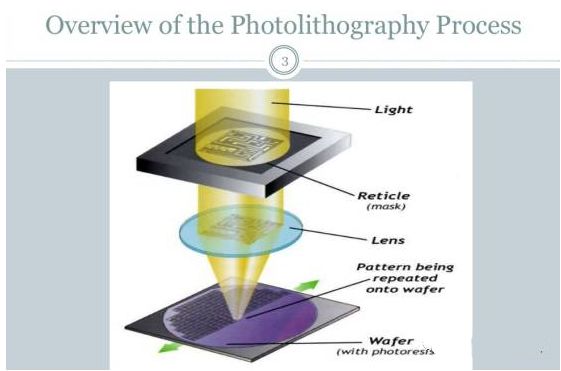
Principle of lithography
Lithography is not a simple process, it goes through many steps:
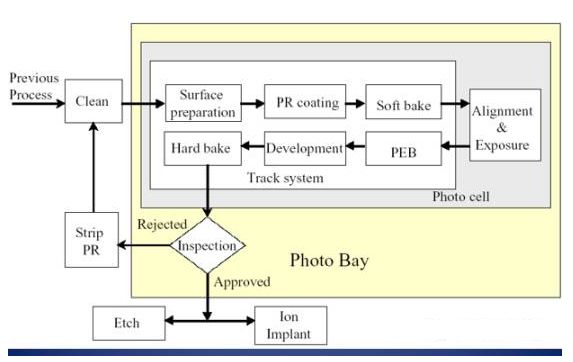
Lithography process
Let's take a closer look at the lithography process:
First, clean the wafer (Wafer Clean)
The purpose of cleaning silicon wafers is to remove contaminants to remove particles, reduce pinholes and other defects, and improve photoresist adhesion.
Basic steps: chemical cleaning - rinsing - drying.
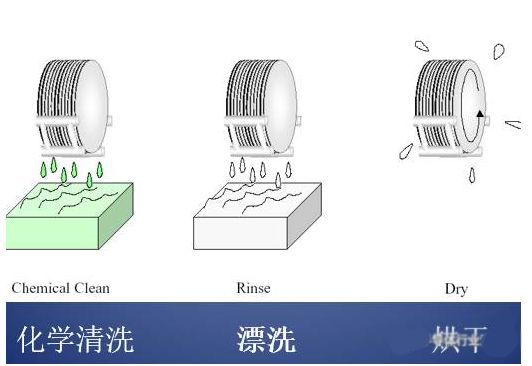
After the silicon wafer is processed through different processes, the surface has been seriously stained. Generally speaking, the surface contamination of the silicon wafer can be roughly divided into three categories:
A. Contamination of organic impurities: It can be combined with ultrasonic cleaning technology by the dissolution of organic reagents.
Remove.
B. Particle Contamination: Physical methods can be used to remove particles with a particle size of ≥ 0.4 μm by mechanical scrubbing or ultrasonic cleaning, and ≥ 0.2 μm particles can be removed with megasonic waves.
C. Metal ion contamination: Chemical contamination must be used to clean the stain. There are two main types of metal contamination on the surface of the silicon wafer:
a. One type is a contaminating ion or an atom attached to the surface of a silicon wafer by adsorption dispersion.
b. The other type is a positively charged metal ion that is attached to the surface of the electron (such as "plating") to the surface of the wafer.
The purpose of chemical cleaning of silicon polishing pads is to remove such contamination, which can generally be cleaned and removed as described below.
a. Use a strong oxidizing agent to "plate" metal ions attached to the silicon surface, oxidize to metal, dissolve in the cleaning solution or adsorb on the surface of the silicon wafer.
b. Replace the metal ions adsorbed on the surface of the silicon wafer with a harmless small-diameter strong positive ion (such as H+) to dissolve it in the cleaning solution.
c. Ultrasonic cleaning with a large amount of deionized water to remove metal ions from the solution.
The immersion RCA chemical cleaning process proposed by RCA Laboratories in the United States has been widely used since 1970. In 1978, the RCA laboratory introduced the megasonic cleaning process. In recent years, various cleaning technologies based on RCA cleaning theory have been developed. For example, FSI of the United States introduced centrifugal spray chemical cleaning technology, Full-Flow systems closed overflow cleaning technology introduced by American CFM Company, and chemical cleaning technology between immersion and closed type introduced by VERTEQ. (Example Goldfinger Mach2 cleaning system), double-sided rinsing technology of SSEC Company of the United States (such as M3304 DSS cleaning system), Japan proposed chemical-free ion-ion water cleaning technology (cleaning with dielectric ultra-pure ionized water) to make polishing sheet Surface cleaning technology has reached a new level of HF / O3 based silicon wafer chemical cleaning technology.
Second, pre-bake and primer coating (Pre-bake and Primer Vapor)
Since the photoresist contains a solvent, it is required to be about 80 degrees for the photoresist-coated silicon wafer. Dehydration baking of silicon wafers removes moisture from the surface of the wafer and enhances the adhesion of the photoresist to the surface, typically around 100 °C. This is done in combination with the primer coating.
The primer coat enhances the adhesion of the photoresist (PR) to the surface of the wafer. Widely used: (HMDS) hexamethyldisilazane, HMDS vapor coating before PR spin coating, cooling plate with a cooling plate before PR coating.
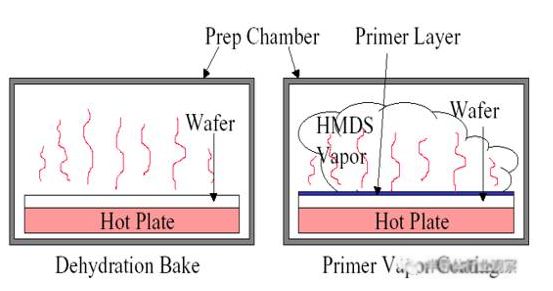
Pre-bake and primer vapor coating
Third, photoresist coating (Photoresist Coating)
The usual step of photoresist coating is to wet oxidize at 900-1100 degrees before applying the photoresist. The oxide layer can be used as a film for wet etching or B implantation. As a first step in the lithography process itself, a thin layer of UV-sensitive organic polymer compound, commonly known as a photoresist, is applied to the surface of the sample (SiO2). First, the photoresist is taken out of the container to the surface of the sample placed in the glue applicator (the sample is fixed on the sample stage by vacuum vacuum), and the sample is then rotated at a high speed, the speed is determined by the viscosity of the glue and the thickness of the desired glue. determine. At such high speeds, the glue flows toward the edges under the action of centrifugal force.
The gluing process is the first and most important step in the graphics conversion process. The quality of the glue directly affects the defect density of the device being processed. In order to ensure the repeatability of the line width and the subsequent development time, the uniformity of the thickness of the same sample and the consistency of the thickness between the different samples should not exceed ±5 nm (±0.3% for a thickness of 1.5 um).
The target thickness of the photoresist is determined by considering the chemical properties of the glue itself and the fineness of the lines and gaps in the pattern to be reproduced. Too thick glue can cause edge coverage or connectivity, hillocks or field-like gelatinous appearance, resulting in a decrease in yield. In MEMS, the thickness of the glue (after baking) is between 0.5 and 2 um, while for special microstructures, the thickness of the glue is sometimes on the order of 1 cm. In the latter case, the spin coating is replaced by a method such as casting or plasma gel polymerization. The optimization of the conventional photoresist coating process requires consideration of the dispensing speed, the amount of dispensing, the rotational speed, the ambient temperature and the humidity, etc. The stability of these factors is important.
Here, the main component of the photoresist is a polymer (resin), a sensitizer, and a solvent. The polymer changes its structure when irradiated, the solvent allows it to be gelled and forms a film on the surface of the sample, and the sensitizer controls the chemical reaction of the polymerization phase. A photoresist that does not contain a sensitizer is sometimes referred to as a unit or a unitary system, and a sensitizer is referred to as a binary system. Solvents or other additives are generally not counted as they are not directly involved in the photochemical reaction of the photoresist.
Depending on the nature, photoresists can be divided into positive and negative glues.
In the early days of process development, negative adhesives have dominated the lithography process. With the advent of VLSI ICs and 2 to 5 micron graphic sizes, negative adhesives have been unable to meet the requirements. Positive glue appeared later, but the disadvantage of positive glue is poor bonding ability.
It is necessary to change the polarity of the mask with positive glue, which is not a simple graphic flip. Because the mask is combined with two different photoresists, the size of the photolithographic surface is different. Due to the diffraction effect of light around the pattern, the negative and bright field masks are combined in the light. The size of the graphic obtained on the engraved layer is smaller than the size of the graphic on the mask. The combination of positive and dark field masks will increase the size of the pattern on the photoresist layer.
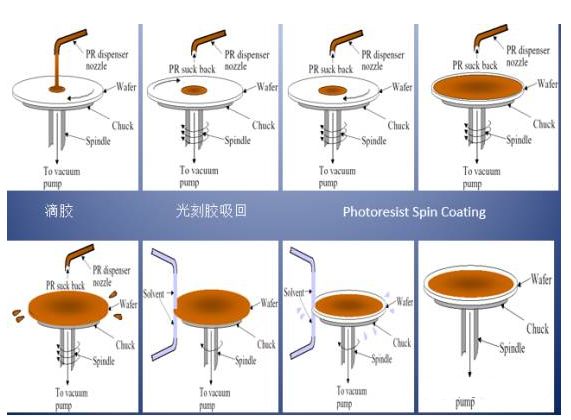
Photoresist coating
Fourth, before baking (Soft Bake)
After the application of the photoresist, a soft drying operation is required, which is also referred to as pre-baking. The pre-bake can evaporate the solvent solvent in the photoresist, making the coated photoresist thinner.
In the liquid photoresist, the solvent component accounts for 65%-85%. Although the liquid photoresist has become a solid film after the silicone, there are still 10%-30% of the solvent, which is easy to stain the dust. By baking at a higher temperature, the solvent can be volatilized from the photoresist (the solvent content after pre-baking is reduced to about 5%), thereby reducing dust contamination. At the same time, this step can also reduce the film stress caused by high-speed rotation, thereby improving the adhesion on the photoresist substrate.
In the pre-baking process, the thickness of the photoresist is also reduced due to solvent evaporation, and the general thickness is about 10%-20%.
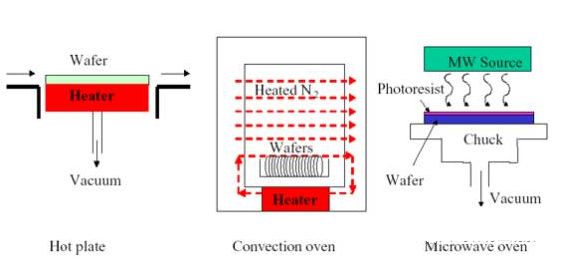
Baking Systems
Fourth, alignment (Alignment)
Lithography alignment technology is one of the three core technologies of lithography before exposure. It generally requires alignment accuracy of 1/7---1/10 of the finest line width. As lithography resolution increases, alignment accuracy requirements become higher and higher. For example, for a 45am line width dimension, the alignment accuracy is required to be around 5am.
Driven by the increased resolution of lithography, alignment technology has also experienced rapid and diverse development. From the alignment principle and marking structure classification, the alignment technique is from the geometric imaging alignment in early projection lithography, including video image alignment, binocular microscope alignment, etc., to the subsequent zone plate alignment. , interference intensity alignment, laser heterodyne interference, and moiré fringe alignment. From the alignment signal, it mainly includes microscopic image alignment of the mark, alignment based on the light intensity information, and alignment based on the phase information.
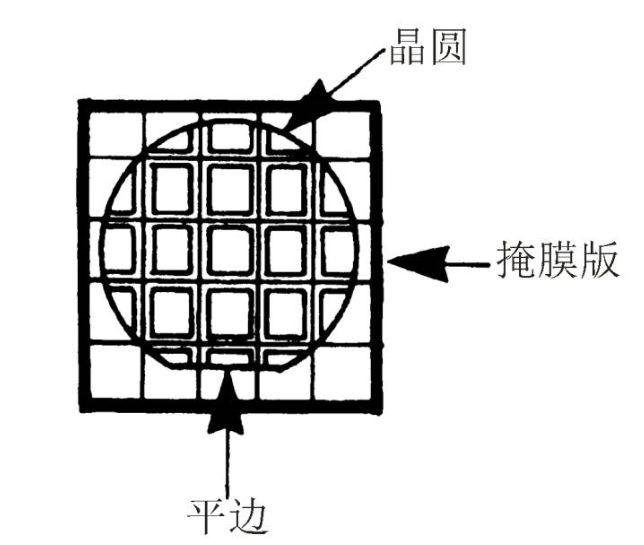
The alignment rule is that the first photolithography simply sets the Y-axis on the mask to 90o on the flat side of the crystal, as shown. The next mask is aligned with the mask with the pattern on the previous layer. The alignment mark is a special pattern (see figure) that is distributed at the edge of each chip pattern. The lithographic alignment marks are always left on the surface of the chip and used as the next alignment.
The alignment method includes:
a, pre-alignment, laser auto-alignment through notch or flat on the silicon wafer
b. By aligning the mark, it is located on the cutting groove. In addition, the alignment between the layers, that is, the engraving precision, ensures the alignment between the pattern and the already existing pattern on the silicon wafer.
5. Exposure
In this step, the photoresist covering the substrate is selectively illuminated using light of a specific wavelength. The sensitizer in the photoresist undergoes a photochemical reaction to change the chemical composition of the region (the photosensitive region) where the positive photoresist is irradiated and the region (non-photosensitive region) where the negative photoresist is not irradiated. These areas where the chemical composition changes can be dissolved in a specific developer in the next step.
After receiving the light, the sensitizer DQ in the positive photoresist undergoes a photochemical reaction to become ketene, and further hydrolyzed to indene-Carboxylic-Acid (CA), and the carboxylic acid is in an alkaline solvent. The solubility is about 100 times higher than that of the non-photosensitive portion of the photoresist, and the resulting carboxylic acid also promotes dissolution of the phenolic resin. The transfer of the mask pattern can be performed by using different sensitivities of the photosensitive and non-photosensitive photoresists to the alkaline solvent.
Exposure method:
a. Contact Printing The mask is directly in contact with the photoresist layer.
b. Proximity Printing The mask is slightly separated from the photoresist layer by about 10 to 50 μm.
c. Projection Printing. Exposure is achieved by using a lens to collect light between the mask and the photoresist.
d, stepper exposure (Stepper)
Here is a special mention of the classification of projection exposure:
The two most important parameters in exposure are:
1. Exposure energy (Energy)
2. Focus (Focus)
If the energy and focus are not well adjusted, you will not be able to get the required resolution and size of the graph. The critical dimensions of the graphic appear to be outside the required range.
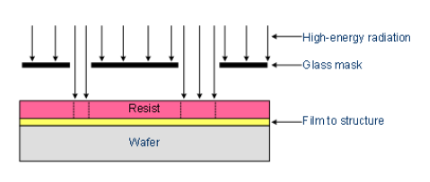
Sixth, development (development)
By adding the developer after the end of the exposure process, the photosensitive region of the positive photoresist and the non-photosensitive region of the negative photoresist are dissolved in the developer. After this step is completed, the pattern in the photoresist layer can be visualized. In order to improve the resolution, almost every photoresist has a special developer to ensure high-quality development.
The developing process causes the recessive pattern to be formed during the exposure process to become a dominant pattern of the photoresist in the past, as a film for the next processing. What is carried out in development is the process of selective dissolution, the most important being the ratio of dissolution rates (DR) between the exposed and unexposed areas. Commercial positive gels have a DR ratio greater than 1000, a dissolution rate of 3000 nm/min in the exposed zone, and only a few nm/min in the unexposed zone.
There are now two development methods, one is wet development, which is widely used in IC and micromachining, and the other is dry development.
a, the entire box of silicon immersion development (Batch Development).
Disadvantages: the developer consumption is large; the uniformity of development is poor;
b. Continuous Spray Development / Auto-rotation Development. One or more nozzles spray the developer on the surface of the wafer while the wafer is rotating at a low speed (100 to 500 rpm). The nozzle spray pattern and wafer rotation speed are key tuning parameters for achieving repeatability of dissolution and uniformity between wafers.
c, Puddle Development (Puddle Development). Spray the developer enough (not too much, minimize back humidity) onto the surface of the wafer and form a puddle shape (the flow of developer remains low to reduce variations in edge development rate). The wafer is fixed or rotated slowly. It is generally used to repeatedly coat the developer: first coating, holding for 10 to 30 seconds, removing; second coating, holding, and removing. Rinse with deionized water (remove all chemicals on both sides of the wafer) and spin dry. Advantages: less developer solution; uniform development of silicon wafers; minimized temperature gradient.
Developer:
a. A developer of a positive photoresist. The developing solution of the positive gel is an alkaline aqueous solution. KOH and NaOH are generally not used in IC manufacturing because they cause Movable Ion Contamination. The most common positive gel developer is tetramethylammonium hydroxide (TMAH) (standard equivalent concentration of 0.26, temperature 15 to 250 C). A carboxylic acid is formed in the exposure of the I-line photoresist, and the alkali and acid in the TMAH developer are neutralized to dissolve the exposed photoresist in the developer, while the unexposed photoresist has no effect; in the chemically amplified photoresist The phenolic resin contained in (CAR, Chemical Amplified Resist) is present in the form of PHS. The acid produced by the PAG in CAR removes the protecting group (t-BOC) in the PHS, allowing the PHS to be rapidly dissolved in the TMAH developer. TMAH did not react with PHS during the entire development process.
b. Developer of negative photoresist. Xylene. The cleaning solution is butyl acetate or ethanol or trichloroethylene.
Common problems in development:
a, Incomplete Development. A photoresist remains on the surface. Insufficient developer solution;
b. Under Development. The developed sidewall is not vertical and is caused by insufficient development time;
c. Over Development. The photoresist near the surface is excessively dissolved by the developer to form a step. The development time is too long.

Hard Bake
After the development of the glue is completed, the pattern is basically determined, but it is also necessary to make the properties of the photoresist more stable. Hard drying can achieve this goal, and this step is also known as hardening. In this process, high temperature treatment can remove the solvent remaining in the photoresist, enhance the adhesion of the photoresist to the surface of the silicon wafer, and improve the resist resistance of the photoresist during subsequent etching and ion implantation. . In addition, the photoresist will soften at high temperatures, forming a molten state similar to that of the glass body at high temperatures. This smoothes the surface of the photoresist under surface tension and reduces defects (such as pinholes) in the photoresist layer, thus correcting the edge profile of the photoresist pattern.
The sample was treated as a whole with O2 plasma to remove the possible undesirable residue called de-scumming after development. In particular, negative gels, but also positive gels, leave a thin layer of polymer at the original glue-substrate interface after development, a problem that is more severe in structures with structures less than 1 um or large depth-to-width ratios. Of course, the thickness of the glue will be reduced during the De-scumming process, but the impact will not be too great.
Finally, hard bake is required to remove residual developer and water prior to etching or plating, and annealed to improve interfacial bonding due to penetration and expansion during development. At the same time, the hardness of the glue is improved and the etching resistance is improved. The hard roasting temperature is generally above 120 degrees, and the time is also around 20 minutes. The main limitation is that too high a temperature can make the edges of the pattern worse and difficult to remove after etching.
Method: hot plate, 100 ~ 1300C (slightly higher than the glass transition temperature Tg), 1 ~ 2 minutes.
purpose:
a, completely evaporate the solvent inside the photoresist (to avoid contamination of the subsequent ion implantation environment, such as nitrogen in the DNQ phenolic resin photoresist will cause local cracking of the photoresist);
b, hard film to improve the ability of the photoresist to protect the lower surface during ion implantation or etching;
c, further enhancing the adhesion between the photoresist and the surface of the silicon wafer;
d. Further reduce the standing wave effect.
common problem:
a, under baking (Underbake). The strength of the photoresist (resistance to etching and blocking in ion implantation) is reduced; the Gapfill Capability for the needle hole is reduced; and the adhesion to the substrate is reduced.
b, overbake (Overbake). The flow of the photoresist is caused to lower the accuracy of the pattern and the resolution is deteriorated. In addition, deep ultraviolet (DUV, Deep Ultra-Violet) can be used. The positive photoresist resin is crosslinked to form a thin surface hard shell, which increases the thermal stability of the photoresist. In the subsequent plasma etching and ion implantation (125 to 2000 C) processes, the reduction in resolution due to the high temperature flow of the photoresist is reduced.
Seven, etching or ion implantation
Etching (etching) is a process in which semiconductor devices are used to selectively remove specific portions of a deposited layer by chemical means. Etching is important for the electrical performance of the device. If a mistake occurs during the etching process, the silicon wafer that is difficult to recover will be scrapped, so strict process control must be performed. Each layer of the semiconductor device undergoes multiple etching steps.
Etching is generally divided into electron beam etching and photolithography. Photolithography requires high flatness of materials and, therefore, requires high cleanliness. However, for electron beam etching, since the wavelength of electrons is extremely short, the resolution is much better than that of photolithography. Since the mask is not required, the flatness is not required, but the electron beam etching is slow and the equipment is expensive.
For most etching steps, part of the upper layer of the wafer is protected by a "hood" that cannot be etched so that specific portions of the layer can be selectively removed. In some cases, the material of the cover is photoresist, similar to the principles utilized in lithography. In other cases, the etch mask needs to withstand certain chemicals, and silicon nitride can be used to make such a "hood."
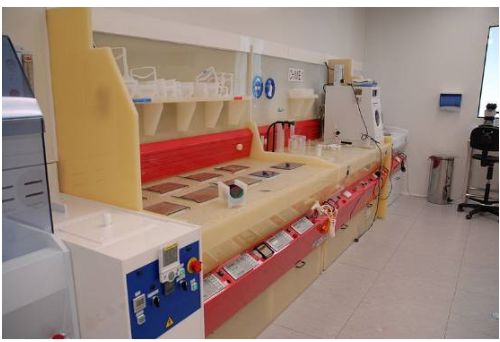
Ion implantation is a technical means of accelerating a particular ion in an electric field and then embedding it into another solid material. The use of this technology can change the physicochemical properties of solid materials and is now widely used in semiconductor device fabrication and certain materials science research. Ion implantation can result in nuclear transformation or alter the crystal structure of certain solid materials.
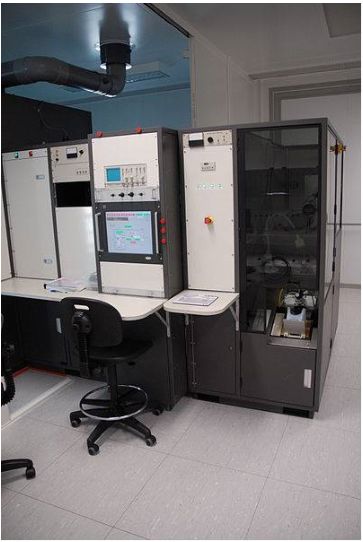
Eight, photoresist removal
The primary function of the photoresist is to protect the portion of the substrate under the photoresist during chemical or mechanical processing throughout the region. Therefore, after the above process is finished, the photoresist should be completely removed, and this step is referred to as degumming. Only those photoresists that are stable at high temperatures, such as light-sensitive polyimides, can remain on the device as an intermediate medium or buffer coating.
To avoid any damage to the treated surface, a mild chemical method at low temperatures should be used. Ultrasonic applications can also enhance peel performance. Because of corrosion problems, some known stripping fluids do not work with metal surfaces such as aluminum; in this case, ozone or oxygen plasma (ashing) is first used. These plasmas have also been successfully used as photolithographic strippers for non-aluminum surfaces, but damage to the surface of the device remains a problem to be solved.
After etching or ion implantation, the photoresist is no longer required as a protective layer and can be removed. The methods of removing glue are classified as follows:
Wet method
Organic solvent removal: removal of photoresist by organic solvent
Inorganic solvent: the carbon element in the organic substance of the photoresist is oxidized to carbon dioxide by using some inorganic solvent, and then removed.
Dry degumming: stripping photoresist with plasma
In addition to these main processes, some auxiliary processes are often used, such as performing large-area uniform etching to reduce the thickness of the substrate, or removing the unevenness of the edges. Generally, in the production of semiconductor chips or other components, one substrate requires repeated photolithography.
The above is the lithography step, hereby collect it for everyone, hope to correct.
CoolPlay Disposable ecig have a completely enclosed design, reducing the need for charging and replacing cartridges. The no-charge design also reduces the occurrence of faults. It is understood that with rechargeable e-cigarettes, each cartridge needs to be charged at least once and the battery efficiency is extremely low, while the design of disposable ecig can solve this problem very well.
Coolplay Disposable E-Cigarette,Coolplay Mini E Cigarette,Coolplay Electronic Cigarette Customizing,Rechargeable E Cigarette
Shenzhen E-wisdom Network Technology Co., Ltd. , https://www.healthy-cigarettes.com
